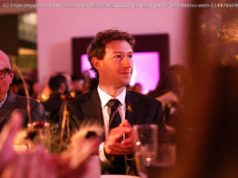A documentary film captures Dane Johansen’s project to hike the Camino de Santiago in northern Spain while recording Bach’s suites for solo cello.
More than 200,000 pilgrims throng the Camino de Santiago each year, walking a network of trails through northern Spain to the shrine of Saint James in Santiago de Compostela. Some are drawn by the challenge of a long-distance hike. Many walk in search of clarity as they process an illness, trauma or crisis of faith.
In 2014, the Alaskan-born cellist Dane Johansen added a musical quest: Hiking the 600-mile path with his instrument strapped to his back, he recorded Bach’s six suites for solo cello in 36 churches along the way.
A documentary film, “Strangers on the Earth,” which is screening at Cinema Village in New York through May 17 and opens in Los Angeles on June 1, captures something of the ardor and elation of the experience. In a phone interview, Mr. Johansen, 33, compared the need to pace himself on his 45-day journey with the search for a natural rhythm in Bach.
“You have to find for yourself what is the natural tempo that brings you through these pieces,” he said. “There is so much opportunity for space. Once I found that pace, everything happened more naturally, and there was an almost improvisational quality in the music.”
Mr. Johansen sometimes appears touchingly vulnerable in the film; at one point, his frustration with the imperfections that crept into his performance after a long day on the trail was obvious. His fingers were swollen, his body was sore, and there had been no time to practice before facing an expectant audience in an unheated chapel.
“It was difficult to get my ego around those challenges,” he said. At the same time, his fellow travelers — some of whom adjusted their walking plans to follow his performances — encouraged him to think of his music-making as a gift.
“I had people describe to me that the music was like a balm for weary travelers at the end of the day,” he said. “There’s something cosmic and essentially human about Bach’s music. So even though I wasn’t always feeling my absolute best, it was an incredible opportunity to share that with those people.”
There was not just his body but also his instrument to worry about. One sunny but chilly morning, Mr. Johansen opened his case to find his cello beaded with condensation and was terrified he’d ruined it. The cello turned out to be fine, but a member of the crew filming him suggested packing the empty space inside his case with diapers, the silicone gel in which would suck up humidity.
Another volatile factor was the acoustics in the 36 religious spaces in which Mr. Johansen performed. Their varying size, design and building materials made for vastly different sonic environments, each with its own degree of reverberation, clarity and warmth.
“Some of my favorite ones were the Romanesque churches that were built of this beautiful soft stone,” Mr. Johansen said. “You can play a note and listen to it take on a life of its own.”
In the city of Leon, the cathedral was opened to him for a private tour. “We got to go into this dark, cool Gothic cathedral with the morning sun coming in through these incredible stained glass windows,” he recalled. “It was amazing to play Bach in there. It was probably the largest space I’ve ever occupied by myself with music.”
These days Mr. Johansen’s musical life is rarely so isolated. On completing the Camino, he bid farewell to the touring life he had enjoyed as a member of the Escher String Quartet and joined the Cleveland Orchestra. The humility imposed on him by the pilgrimage survives in his new professional life.
“There is something really selfless about playing in an orchestra,” he said. “You have to give everything you have to this ensemble and to the music. But nothing of you as an individual is going to shine.”
But he has continued to perform as a soloist, including at house concerts in New York, where he’s been able to get to know members of the audience before putting bow to string. One epiphany he had on the trail, he said, was that “my continuing life with music has to include a regular dose of this kind of opportunity, to share music with people in a more intimate setting than you get with lights and a stage.”






